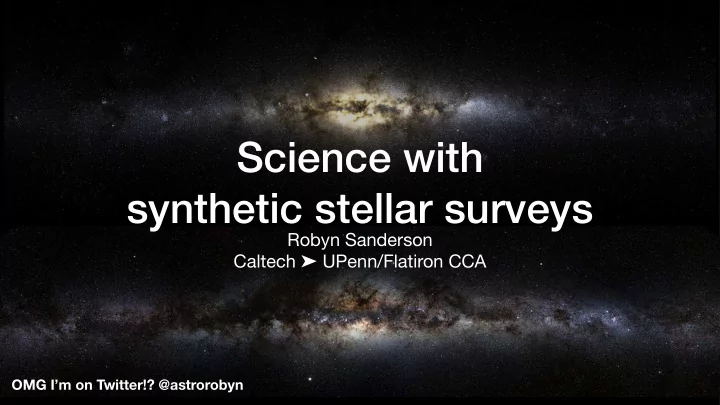

Science with synthetic stellar surveys Robyn Sanderson Caltech ➤ UPenn/Flatiron CCA OMG I’m on Twitter!? @astrorobyn
Synthetic survey of a cosmo-hydro simulation (Sanderson et al 2018) Science with synthetic stellar surveys Robyn Sanderson Caltech ➤ UPenn/Flatiron CCA Milky Way (image credit:ESO) OMG I’m on Twitter!? @astrorobyn
N$ PAndAS$M31$Map$ The Milky Way (McConnachie$et$al.)$ N147$ N185$ E$ (and M31) in 2018 35 kpc (MSTO stars, Sesar+2011) 85 kpc 30$kpc$ 60$kpc$ 90$kpc$ 150$kpc$ M31$ (F stars, Pila-Diéz+2015) 150 kpc (SEGUE K giants, Xue +2014; Giant$Southern$ PanSTARRS RR Lyr, Sesar+2017) Stream$ M31$dSphs$ 300 kpc M31$Halo$Fields$ (Rvir?) M33$ Dwarf$Galaxy$Fields$ 274 kpc image courtesy Karoline Gilbert (Most distant M giant, Bochanski, Willman, Caldwell, RES+2014)
The next decade will see a Galactic renaissance 1 1 E. Kirby, 2017 2017 2018 2019 2020 2021 2022 2023 2024 2025 LSST By 2028, we will have 6+D information Gaia Ext for stars to the MW’s Euclid WFIRST virial radius and beyond (~300 kpc)… Subaru PFS 4MOST ..and resolved stellar DESI maps of the ~100 nearest WEAVE MW-like galaxies SDSS-V GMT Astrometric + spectroscopic Spectroscopic: <4-m class Photometric + astrometric Spectroscopic: >4-m class TMT
The Milky Way in M giants, RRLe 2028 LSST coadded depth MSTO stars (m=26.7) 5 Mpc 300 kpc (=Rvir?) 150 kpc (extent of current samples) BHB stars Latte (m21i), Wetzel et al. 2016
The Milky Way in 2028: spectroscopy Effective temperature (K) 30 000 10 000 7000 6000 4000 –10 Limiting distance –8 Supergiants ( I ) AGB –6 1 Mpc 10 M ☉ star –4 Helium Absolute magnitud ( V –band) flash –2 5 M ☉ star 100 kpc 0 Giants ( II , III ) 10 kpc HB M a i n 2 s RGB e q u e n c e 4 10 kpc ( V ) 1 kpc Sun 6 8 1 kpc RGB - Red Giant Branch White dwarfs (WD) 10 100 pc HB - Horizontal Branch Gaia AGB - Asymptotic Giant Branch 12 14 100 pc 4M0ST 05 B5 A0 F0 G0 K0 M0 Spectral class 4MOST; De Jong 2011 Left: The 4MOST goal for radial velocity to nearly the centre of the Milky Way, RGB stars to Wetzel+2016 Group, substantially expanding on Gaia’s spectro 4MOST (black horizontal) overlaid on a Hertzsprung– scopic view. Distance limits for the 4MOST high res limits of 4MOST to the astrometric limits of Gaia, Russell diagram. 4MOST can measure Sun-like stars Effjcient full-sky surveying requires at (AAO) for FMOS (Akiyama et al., 2008) fjbres will permanently go to a spectro multiplex of > 3000 to create a unique, world-class facility. Most fjbres will lead LAMOST) Telescope (Hu et al., 2004). a number of trade-off studies to fjnd the
but…what do we DO with all this data? Gaia Collaboration Wetzel et al. 2016, movie credit: Phil Hopkins Babusiaux et al 2018
The Milky Way in M giants, RRLe 2028 LSST coadded depth MSTO stars (m=26.7) 5 Mpc 300 kpc (=Rvir?) Latte Simulation: arXiv:1602.05957 Figure courtesy Andrew Wetzel 150 kpc (extent of current samples) BHB stars
100 kpc Cooper+2010, Helmi+2011
The accreted stellar halo is clumpy in constants-of-motion space Galactic coordinates Radial action (~energy) One particle = many stars Z angular momentum Constants of motion Sanderson , Helmi, & Hogg 2015 (using best-fit mass model for host galaxy) Sanderson et al. 2017a
The stellar halo constrains the MW's gravitational potential Best fit mass profile Radial action (~energy) Distances to stars used in fit Z angular momentum Sanderson et al. 2017a
The choice of stellar tracers matters K giants RR Lyrae K giants 20% “photometric distances” RR Lyrae 5% standard candles Sanderson et al. 2017b Sanderson 2016
A route to untangling the stellar halo One particle = many stars Sanderson et al. 2017c
Making predictions for a 6+D galaxy Synthetic Survey one particle = one “observed” star Galaxy Simulation Stellar Populations (cosmology, DM model, gravity, gas physics, star (stellar structure, stellar evolution, formation, stellar feedback, …) convection models, isochrone mapping, IMF, …) Phase-space density estimation (kernel dimension, smoothing scales, ages, accretion history, …) Survey description Mock Catalog (Magnitude/color limits, one particle = extinction/reddening, one synthetic star selection function, error model, instrument model, …) One particle = many “stars” …with same age, abundances
• Cosmological sim with hydro —> realistic central MW Ananke • 6D + 10 abundances + ages + … Sanderson et al. 2018, • Complete stellar populations arXiv:1806.10564 Andrew Wetzel Sarah Loebman Sanjib Sharma girder.hub.yt Available for Gaia DR2 on: irsa.ipac.caltech.edu
• Cosmological sim with hydro —> realistic central MW Ananke • 6D + 10 abundances + ages + … Sanderson et al. 2018 • Complete stellar populations arXiv:1806.10564 Mock Gaia Stars with: • 10% or better parallax uncertainty • extinction < 0.015 mag • G mag uncertainty <0.22 mag • G Bp , G Rp uncertainty < 0.054 mag Real Gaia girder.hub.yt Available for Gaia DR2 on: Babusiaux et al 2018 irsa.ipac.caltech.edu
• Cosmological sim with hydro —> realistic central MW Ananke • 6D + 10 abundances + ages + … Sanderson et al. 2018 • Complete stellar populations arXiv:1806.10564 m12i-lsr0 Mock Gaia Stars with: • 10% or better parallax uncertainty • extinction < 0.015 mag • G mag uncertainty <0.22 mag • G Bp , G Rp uncertainty < 0.054 mag m12f-lsr2 Real Gaia girder.hub.yt Available for Gaia DR2 on: irsa.ipac.caltech.edu
Things to do with ananke • Validate your Gaia analysis technique (matching columns have same names) • Train/interpret your machine-learning model • Test & tune [some] search algorithms • Investigate cosmic & viewpoint variance Things NOT to do with ananke • Estimate backgrounds/foregrounds (stellar mass/density are not MW calibrated) • Study the edges of the selection function (the built-in error model is way too simple) • Estimate completeness (crowding not treated, extinction function not MW)
Recommend
More recommend